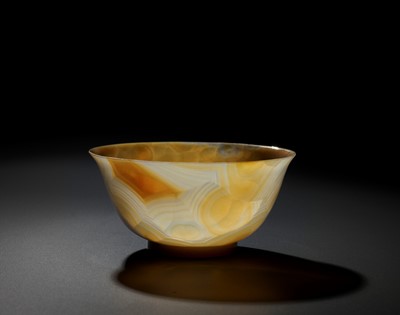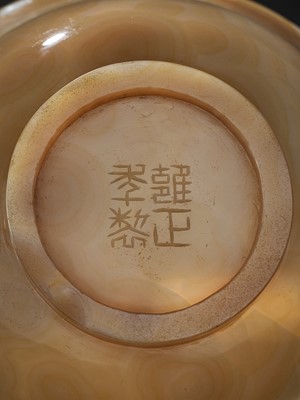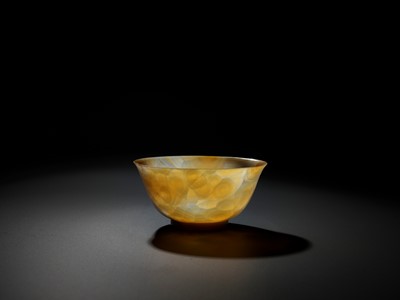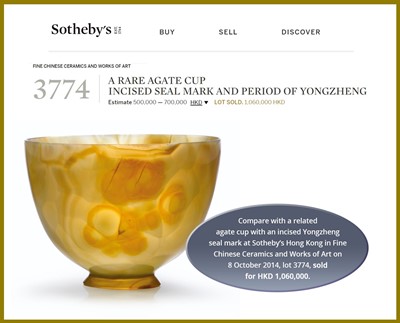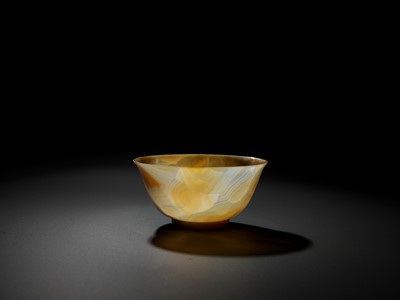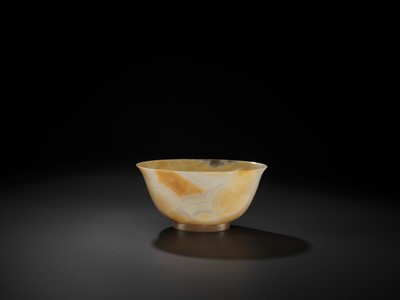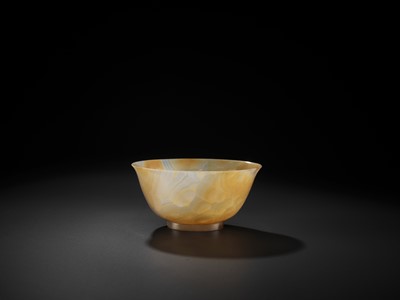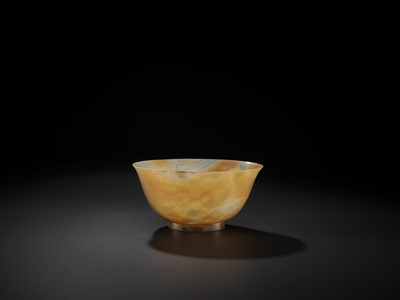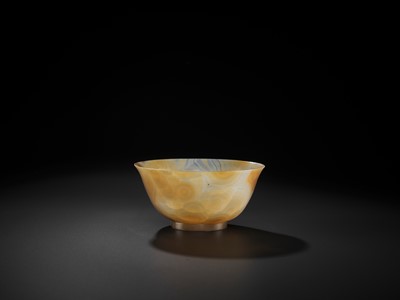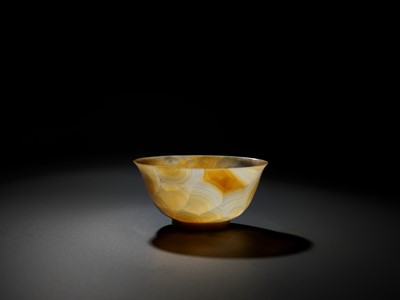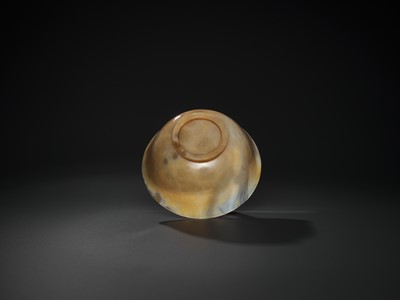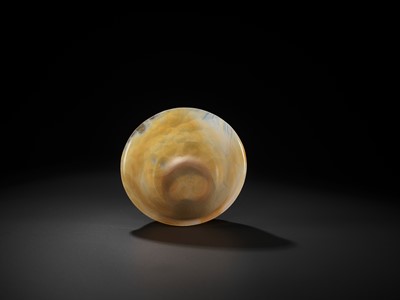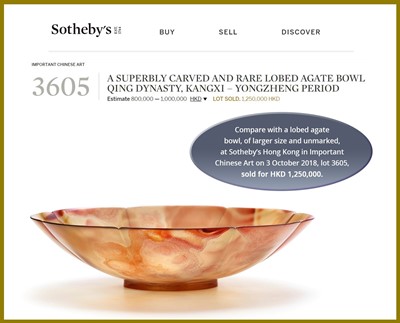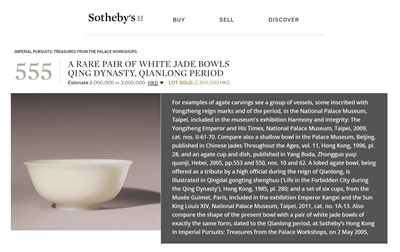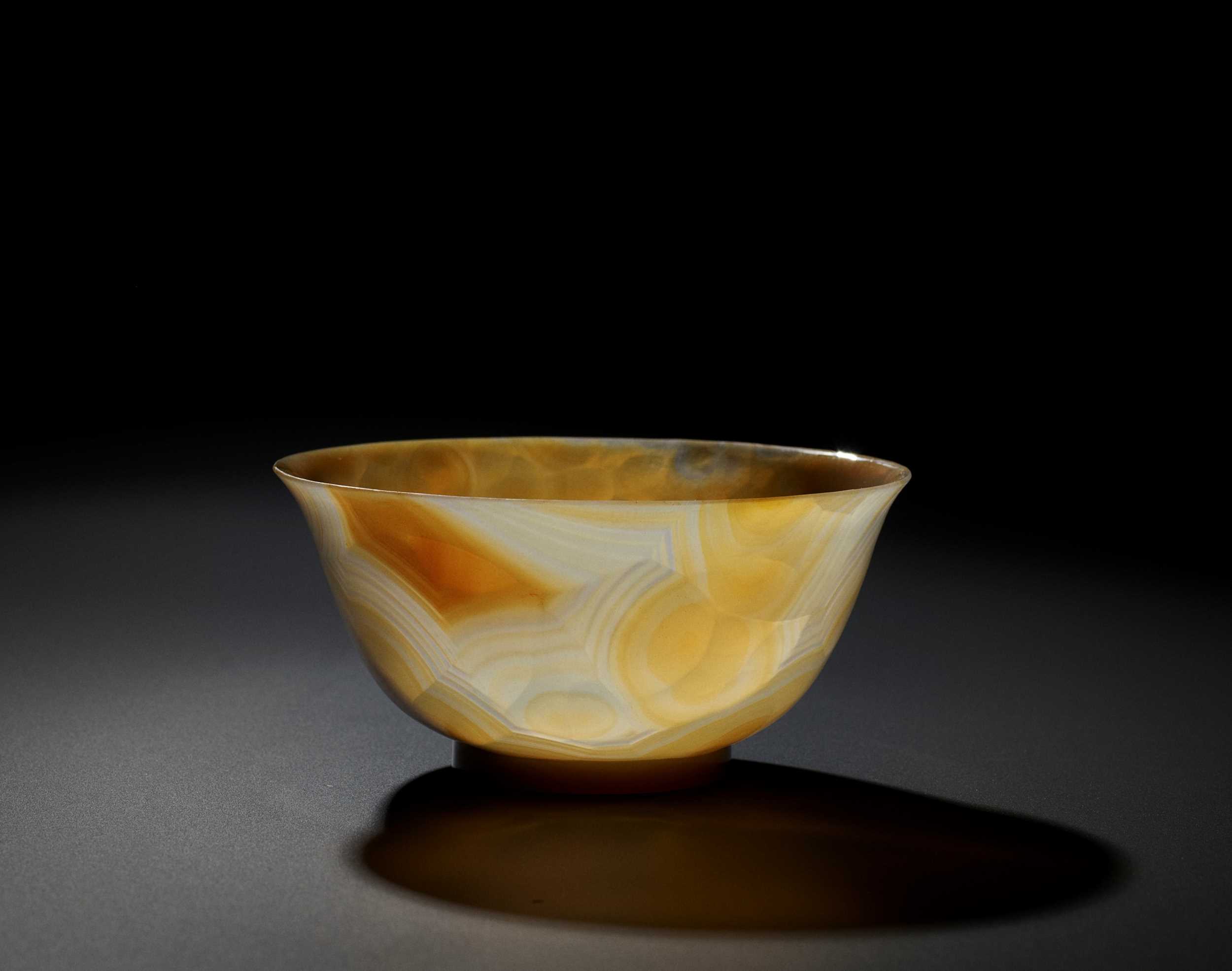5th Mar, 2021 10:00
TWO-DAY AUCTION - Fine Chinese Art / 中國藝術集珍 / Buddhism & Hinduism
35
A TRANSLUCENT BANDED AGATE BOWL, QING DYNASTY
清代瑪瑙碗
Sold for €8,848
including Buyer's Premium
China, 18th-19th century. The deep rounded sides rising from a straight ring foot to a slightly everted rim. The almost transparent stone is brilliantly polished and shows attractive variegated tones of milky gray, caramel, and honey. The base with a neatly incised four-character Yongzheng nianzhi seal mark and possibly of the period.
Provenance: British private collection.
Condition: Excellent condition with minor wear.
Weight: 100.9 g
Dimensions: Diameter 11.2 cm
The agate used for the present bowl is exceptional for both its beautiful coloration and its highly translucent quality. Agate, with rippling layers of color ranging from bright honey to coffee brown, is one of only a few hardstones in ancient China that were valued as much as jade and introduced no later than the Han dynasty. Therefore, the bowl possibly belongs to a group of vessels carved from this material in the Imperial Jade Workshop, yuzuo, within the Imperial Palace Works, Zaobanchu, during the Yongzheng reign and bearing the respective Imperial mark. In any case, it certainly demonstrates the superb craftsmanship achieved almost exclusively by the Imperial Workshops.
The Yongzheng Emperor took a personal interest in the artistic production during his period with a special focus on carved hardstones. Records in the archives of the Imperial Jade Workshops, yuzuo, dated between 1724 and 1729, note that he specifically ordered agate brush washers and bowls to be kept undecorated in order to show the original pattern of the agate stone. Pieces with intricate, cluttered designs or made from stones of unsatisfactory quality were rejected and sent back to the workshops, because only plain, elegant vessels could serve the purpose of showing off the superiority of the stone, while carved designs were literally limited to serve the purpose of hiding natural flaws in the mineral. When comparing the number of agate vessels and jade carvings bearing Yongzheng and Qianlong reign marks, it is evident that the Yongzheng emperor greatly admired the natural virtues of the agate stone, while the Qianlong period saw a much larger output of jade carvings.
Expert’s note: The strictly traditional shape of the present bowl, with its elegantly rounded sides, flared lip and comparatively massive circular foot rim, places it firmly in the 18th century. The exceptional quality of the agate stone and completely undecorated design would make a dating to the Yongzheng period reasonable at the very least. One small detail, however, possibly points to a later date: The inner side of the foot shows a series of irregular grooves from manual lathing, hardly visible to the naked eye. While remnants of such grooves occasionally appear on hardstone carvings from the 18th century and earlier, on an Imperial piece we would expect these to have been eliminated completely by manual polish, even on the inner sides of the foot rim.
Literature comparison: For examples of agate carvings see a group of vessels, some inscribed with Yongzheng reign marks and of the period, in the National Palace Museum, Taipei, included in the museum's exhibition Harmony and Integrity: The Yongzheng Emperor and His Times, National Palace Museum, Taipei, 2009, cat. nos. II-61-70. Compare also a shallow bowl in the Palace Museum, Beijing, published in Chinese Jades Throughout the Ages, vol. 11, Hong Kong, 1996, pl. 28, and an agate cup and dish, published in Yang Boda, Zhongguo yuqi quanji, Hebei, 2005, pp.553 and 550, nos. 10 and 62. A lobed agate bowl, being offered as a tribute by a high official during the reign of Qianlong, is illustrated in Qingdai gongting shenghuo ('Life in the Forbidden City during the Qing Dynasty'), Hong Kong, 1985, pl. 280; and a set of six cups, from the Musée Guimet, Paris, included in the exhibition Emperor Kangxi and the Sun King Louis XIV, National Palace Museum, Taipei, 2011, cat. no. 1A-13. Also compare the shape of the present bowl with a pair of white jade bowls of exactly the same form, dated to the Qianlong period, at Sotheby’s Hong Kong in Imperial Pursuits: Treasures from the Palace Workshops, on 2 May 2005, lot 555.
Auction result comparison: Compare with a related agate cup with an incised Yongzheng seal mark at Sotheby’s Hong Kong in Fine Chinese Ceramics and Works of Art on 8 October 2014, lot 3774, sold for HKD 1,060,000, and a lobed agate bowl, of larger size and unmarked, at Sotheby’s Hong Kong in Important Chinese Art on 3 October 2018, lot 3605, sold for HKD 1,250,000.
清代瑪瑙碗
中國,十八至十九世紀。天然瑪瑙製成,乳白色的底色,飄著焦糖色和蜂蜜色的片狀花斑,間有細密如纏絲的條帶狀紋路。盞身光素,敞口微外撇 ,直圈足,底足刻篆書“雍正年制”兩行款。
來源:英國私人收藏
品相:狀況極好,輕微磨損
重量:100.9 克
尺寸:直徑11.2 厘米
拍賣結果比較:一個相似雍正款瑪瑙碗 售于香港蘇富比Fine Chinese Ceramics and Works of Art 拍場2014年10月 8日,lot 3774, 售價HKD 1,060,000;一件尺寸較大、無落款的瑪瑙碗售于香港蘇富比Important Chinese Art拍場2018年10月3日,lot 3605, 售價HKD 1,250,000。
China, 18th-19th century. The deep rounded sides rising from a straight ring foot to a slightly everted rim. The almost transparent stone is brilliantly polished and shows attractive variegated tones of milky gray, caramel, and honey. The base with a neatly incised four-character Yongzheng nianzhi seal mark and possibly of the period.
Provenance: British private collection.
Condition: Excellent condition with minor wear.
Weight: 100.9 g
Dimensions: Diameter 11.2 cm
The agate used for the present bowl is exceptional for both its beautiful coloration and its highly translucent quality. Agate, with rippling layers of color ranging from bright honey to coffee brown, is one of only a few hardstones in ancient China that were valued as much as jade and introduced no later than the Han dynasty. Therefore, the bowl possibly belongs to a group of vessels carved from this material in the Imperial Jade Workshop, yuzuo, within the Imperial Palace Works, Zaobanchu, during the Yongzheng reign and bearing the respective Imperial mark. In any case, it certainly demonstrates the superb craftsmanship achieved almost exclusively by the Imperial Workshops.
The Yongzheng Emperor took a personal interest in the artistic production during his period with a special focus on carved hardstones. Records in the archives of the Imperial Jade Workshops, yuzuo, dated between 1724 and 1729, note that he specifically ordered agate brush washers and bowls to be kept undecorated in order to show the original pattern of the agate stone. Pieces with intricate, cluttered designs or made from stones of unsatisfactory quality were rejected and sent back to the workshops, because only plain, elegant vessels could serve the purpose of showing off the superiority of the stone, while carved designs were literally limited to serve the purpose of hiding natural flaws in the mineral. When comparing the number of agate vessels and jade carvings bearing Yongzheng and Qianlong reign marks, it is evident that the Yongzheng emperor greatly admired the natural virtues of the agate stone, while the Qianlong period saw a much larger output of jade carvings.
Expert’s note: The strictly traditional shape of the present bowl, with its elegantly rounded sides, flared lip and comparatively massive circular foot rim, places it firmly in the 18th century. The exceptional quality of the agate stone and completely undecorated design would make a dating to the Yongzheng period reasonable at the very least. One small detail, however, possibly points to a later date: The inner side of the foot shows a series of irregular grooves from manual lathing, hardly visible to the naked eye. While remnants of such grooves occasionally appear on hardstone carvings from the 18th century and earlier, on an Imperial piece we would expect these to have been eliminated completely by manual polish, even on the inner sides of the foot rim.
Literature comparison: For examples of agate carvings see a group of vessels, some inscribed with Yongzheng reign marks and of the period, in the National Palace Museum, Taipei, included in the museum's exhibition Harmony and Integrity: The Yongzheng Emperor and His Times, National Palace Museum, Taipei, 2009, cat. nos. II-61-70. Compare also a shallow bowl in the Palace Museum, Beijing, published in Chinese Jades Throughout the Ages, vol. 11, Hong Kong, 1996, pl. 28, and an agate cup and dish, published in Yang Boda, Zhongguo yuqi quanji, Hebei, 2005, pp.553 and 550, nos. 10 and 62. A lobed agate bowl, being offered as a tribute by a high official during the reign of Qianlong, is illustrated in Qingdai gongting shenghuo ('Life in the Forbidden City during the Qing Dynasty'), Hong Kong, 1985, pl. 280; and a set of six cups, from the Musée Guimet, Paris, included in the exhibition Emperor Kangxi and the Sun King Louis XIV, National Palace Museum, Taipei, 2011, cat. no. 1A-13. Also compare the shape of the present bowl with a pair of white jade bowls of exactly the same form, dated to the Qianlong period, at Sotheby’s Hong Kong in Imperial Pursuits: Treasures from the Palace Workshops, on 2 May 2005, lot 555.
Auction result comparison: Compare with a related agate cup with an incised Yongzheng seal mark at Sotheby’s Hong Kong in Fine Chinese Ceramics and Works of Art on 8 October 2014, lot 3774, sold for HKD 1,060,000, and a lobed agate bowl, of larger size and unmarked, at Sotheby’s Hong Kong in Important Chinese Art on 3 October 2018, lot 3605, sold for HKD 1,250,000.
清代瑪瑙碗
中國,十八至十九世紀。天然瑪瑙製成,乳白色的底色,飄著焦糖色和蜂蜜色的片狀花斑,間有細密如纏絲的條帶狀紋路。盞身光素,敞口微外撇 ,直圈足,底足刻篆書“雍正年制”兩行款。
來源:英國私人收藏
品相:狀況極好,輕微磨損
重量:100.9 克
尺寸:直徑11.2 厘米
拍賣結果比較:一個相似雍正款瑪瑙碗 售于香港蘇富比Fine Chinese Ceramics and Works of Art 拍場2014年10月 8日,lot 3774, 售價HKD 1,060,000;一件尺寸較大、無落款的瑪瑙碗售于香港蘇富比Important Chinese Art拍場2018年10月3日,lot 3605, 售價HKD 1,250,000。
Zacke Live Online Bidding
Our online bidding platform makes it easier than ever to bid in our auctions! When you bid through our website, you can take advantage of our premium buyer's terms without incurring any additional online bidding surcharges.
To bid live online, you'll need to create an online account. Once your account is created and your identity is verified, you can register to bid in an auction up to 12 hours before the auction begins.
Intended Spend and Bid Limits
When you register to bid in an online auction, you will need to share your intended maximum spending budget for the auction. We will then review your intended spend and set a bid limit for you. Once you have pre-registered for a live online auction, you can see your intended spend and bid limit by going to 'Account Settings' and clicking on 'Live Bidding Registrations'.
Your bid limit will be the maximum amount you can bid during the auction. Your bid limit is for the hammer price and is not affected by the buyer’s premium and VAT. For example, if you have a bid limit of €1,000 and place two winning bids for €300 and €200, then you will only be able to bid €500 for the rest of the auction. If you try to place a bid that is higher than €500, you will not be able to do so.
Online Absentee and Telephone Bids
You can now leave absentee and telephone bids on our website!
Absentee Bidding
Once you've created an account and your identity is verified, you can leave your absentee bid directly on the lot page. We will contact you when your bids have been confirmed.
Telephone Bidding
Once you've created an account and your identity is verified, you can leave telephone bids online. We will contact you when your bids have been confirmed.
Classic Absentee and Telephone Bidding Form
You can still submit absentee and telephone bids by email or fax if you prefer. Simply fill out the Absentee Bidding/Telephone bidding form and return it to us by email at office@zacke.at or by fax at +43 (1) 532 04 52 20. You can download the PDF from our Upcoming Auctions page.
How-To Guides
How to Create Your Personal Zacke Account
How to Register to Bid on Zacke Live
How to Leave Absentee Bids Online
How to Leave Telephone Bids Online
中文版本的操作指南
创建新账号
注册Zacke Live在线直播竞拍(免平台费)
缺席投标和电话投标
Third-Party Bidding
We partner with best-in-class third-party partners to make it easy for you to bid online in the channel of your choice. Please note that if you bid with one of our third-party online partners, then there will be a live bidding surcharge on top of your final purchase price. You can find all of our fees here. Here's a full list of our third-party partners:
- 51 Bid Live
- EpaiLive
- ArtFoxLive
- Invaluable
- LiveAuctioneers
- the-saleroom
- lot-tissimo
- Drouot
Please note that we place different auctions on different platforms. For example, in general, we only place Chinese art auctions on 51 Bid Live.
Bidding in Person
You must register to bid in person and will be assigned a paddle at the auction. Please contact us at office@zacke.at or +43 (1) 532 04 52 for the latest local health and safety guidelines.
